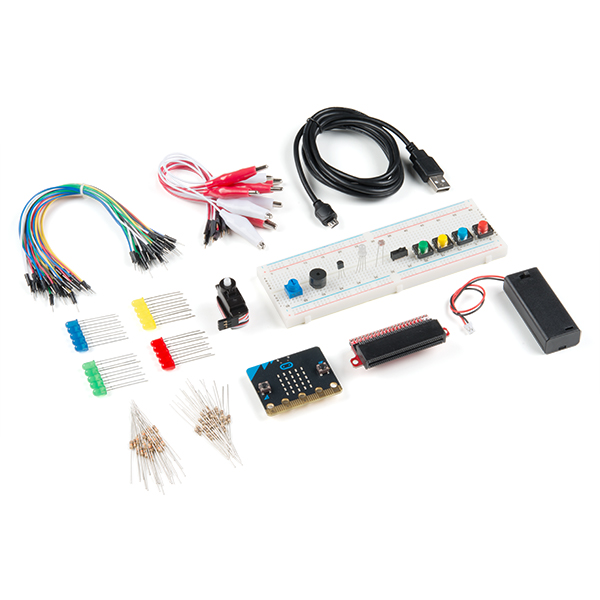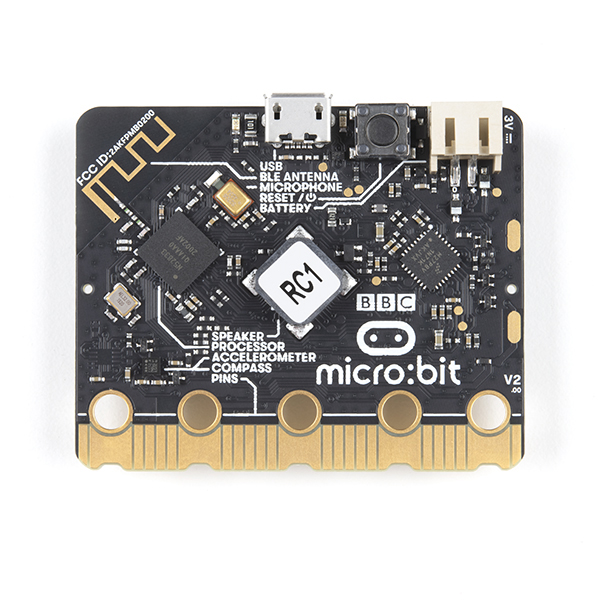SparkFun Inventor's Kit for micro:bit v2
The SparkFun Inventor’s Kit (SIK) for micro:bit v2 is a great way to get creative, connected and coding with the micro:bit. The SIK for micro:bit v2 provides not only the micro:bit v2 board but everything you need to hook up and experiment with multiple electronic circuits! With the SIK for micro:bit v2 you will be able to complete circuits that will teach you how to read sensors, move motors, build Bluetooth® devices and more.
The SparkFun Inventor’s Kit for micro:bit is the latest and greatest in single-board computer kits. Surrounding the micro:bit v2 SIK is one core philosophy --- that anyone can (and should) experiment with cutting-edge electronics in a fun and playful way without breaking the bank.
The kit does not require any soldering and is recommended for all users, from beginners to engineers. We have provided a complete Experiment Guide in the Documents tab for you to check out now! If you have ever been interested in learning about electronics, or if you have used the original SparkFun Inventor’s Kit and are looking for something new, the SIK for micro:bit is the perfect kit for you!
The micro:bit is a pocket-sized computer that lets you get creative with digital technology. Between the micro:bit and our shield-like bit boards you can do almost anything while coding, customizing and controlling your micro:bit from almost anywhere! You can use your micro:bit for all sorts of unique creations, from robots to musical instruments and more. At half the size of a credit card, this versatile board has vast potential!
- micro:bit v2 Board
- SparkFun Qwiic micro:bit Breakout (with Headers)
- Full-Size Breadboard
- micro:bit Battery Holder --- 2xAAA (JST-PH)
- Small Servo
- TMP36 Temperature Sensor
- Photocell
- USB Micro-B Cable --- 6 Foot
- Jumper Wires
- Alligator Clips with Pigtails
- RGB Diffused LED
- Red, Blue, Yellow and Green LEDs
- 10K Trimpot
- Multicolor Button --- 4-pack
- SPDT Mini Power Switch
- Mini Speaker
- 100 Ohm Resistors (Thick Leads)
- 10K Ohm Resistors (Thick Leads)
- Circuit 0: Hello, micro:bit!
- Circuit 1: Blinking an LED
- Circuit 2: Reading a Potentiometer
- Circuit 3: Reading a Photoresistor
- Circuit 4: Driving an RGB LED
- Circuit 5: Reading an SPDT Switch
- Circuit 6: Reading a Button Press
- Circuit 7: Reading the Temperature Sensor
- Circuit 8: Using a Servo Motor
- Circuit 9: Using a Buzzer
- Circuit 10: Using the Accelerometer
- Circuit 11: Using the Compass
SparkFun Inventor's Kit for micro:bit v2 Product Help and Resources
SparkFun Inventor's Kit for micro:bit Experiment Guide
July 21, 2017
This guide contains all the information you will need to explore the twelve circuits of the SparkFun Inventors Kit for micro:bit.
Getting Started with the micro:bit
September 2, 2021
The BBC micro:bit is a compact, powerful programming tool that requires no software installation. Read on to learn how to use it YOUR way!
Getting Started with MicroPython and the SparkFun Inventor's Kit for micro:bit
July 11, 2017
Learn MicroPython with the micro:bit.
Core Skill: Robotics
This skill concerns mechanical and robotics knowledge. You may need to know how mechanical parts interact, how motors work, or how to use motor drivers and controllers.
Skill Level: Noob - You will be required to put together a robotics kit. Necessary parts are included and steps will be easy to follow. You also might encounter basic robotics components like bearings, mounts, or other hardware and need a general idea of how it goes together.
See all skill levels
Core Skill: Programming
If a board needs code or communicates somehow, you're going to need to know how to program or interface with it. The programming skill is all about communication and code.
Skill Level: Rookie - You will need a better fundamental understand of what code is, and how it works. You will be using beginner-level software and development tools like Arduino. You will be dealing directly with code, but numerous examples and libraries are available. Sensors or shields will communicate with serial or TTL.
See all skill levels
Core Skill: Electrical Prototyping
If it requires power, you need to know how much, what all the pins do, and how to hook it up. You may need to reference datasheets, schematics, and know the ins and outs of electronics.
Skill Level: Rookie - You may be required to know a bit more about the component, such as orientation, or how to hook it up, in addition to power requirements. You will need to understand polarized components.
See all skill levels
Comments
Looking for answers to technical questions?
We welcome your comments and suggestions below. However, if you are looking for solutions to technical questions please see our Technical Assistance page.
Customer Reviews
No reviews yet.



